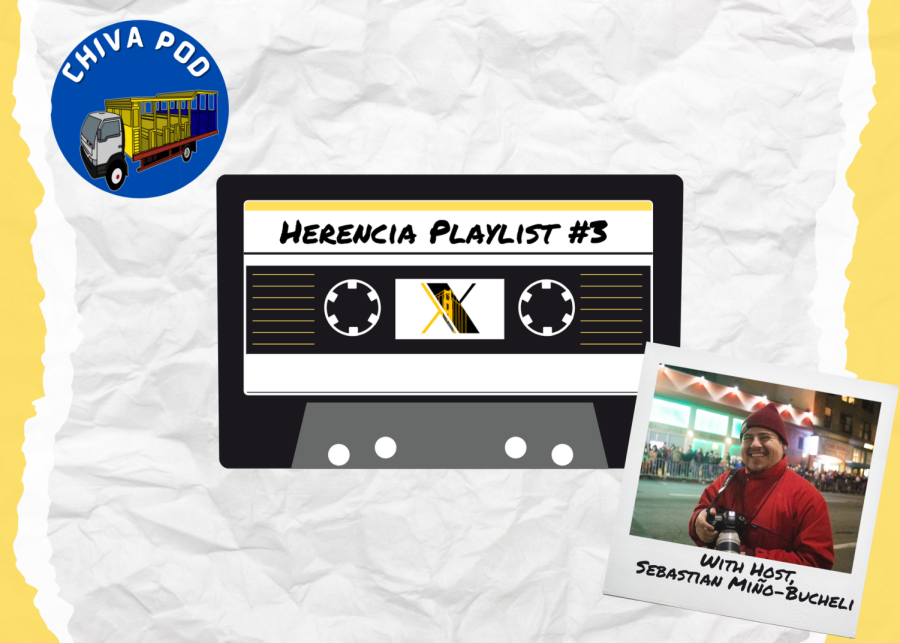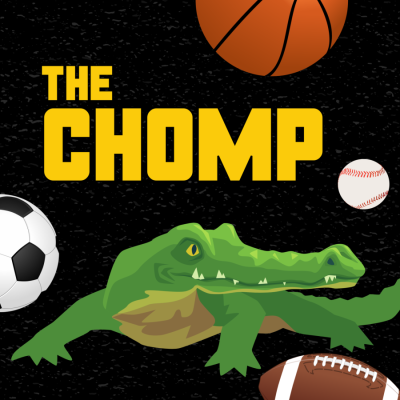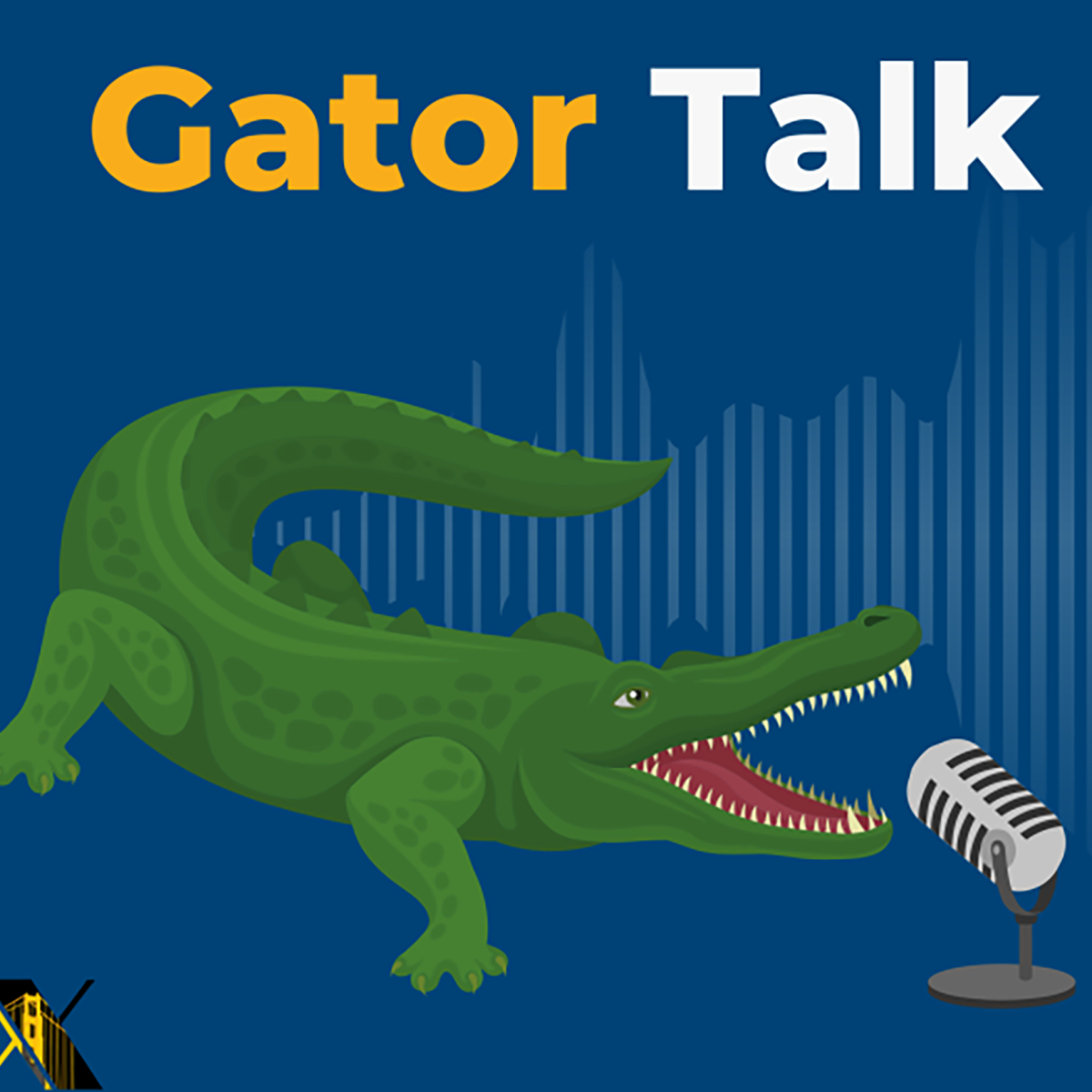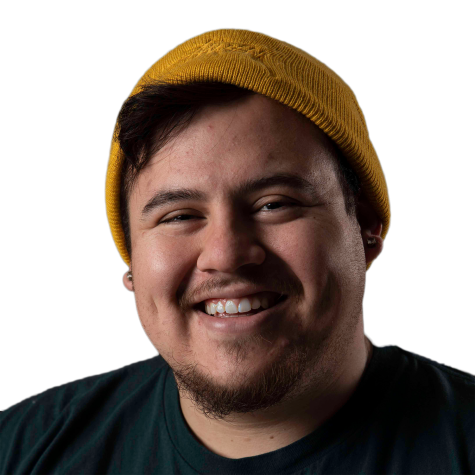Welcome to Chiva Pod, a bilingual podcast for the Latinx community in the San Francisco Bay Area!
It’s the tenth Day of Hispanic Heritage Month! Host Sebastian takes a different approach for stories during Hispanic Heritage Month. Chiva Pod is continuing the Herencia series by asking Latino/a Studies professors, what their playlist for this month looks like? Is it a reflection of their identity, their community, or a reflection of lesser known genres they would love to teach about?
If you’re catching this podcast on Spotify, tune in to Golden Gate Xpress’ account to see the guest DJ playlist.
Chiva Pod
Seb: Bienvenidos a Chiva Pod, I’m your host Sebastian Miño-Bucheli.
Welcome to the third episode of the Herencia playlist. If you’re listening to this episode right here for the first time, Chiva Pod is launching this series by asking Latino/a Studies professors, what their playlist for this month looks like? Is it a reflection of their identity, their community, or a reflection of lesser known genres they would love to teach about?
If this is your first time listening to this series, catch the first two episodes and listen to what your professor has to say.
We’re going to skip the news headlines and go straight to the main story. ¿Listo?
Main Story
Seb: For this episode, I sat down, took a breath of air and reflected as Hispanic Heritage Month comes to an end.
Truthfully, there aren’t enough weeks in this month to get all the SF State professors on the podcast sharing their music. They’re definitely busy trying to cram our history from Sept. 15 to Oct. 15 for Latinx students, non-Latinx people, journalists and other academics.
I don’t want this playlist series to go away when the month ends, so from here on out, when I get a chance to interview someone, you know I’m going to ask them what their playlist looks like.
But what about this episode? Well from the two interviews I’ve done, the two professors asked me what my playlist looks like. I’m sure you’ve thought so as well.
So here’s the breakdown of my playlist.
*Channel changes sound effect*
My parents were born in the Ecuadorian cities, Riobamba and Guayaquil….the sierra and costa. These are two completely different worlds. La Sierra, the highlands, is an area characterized as small towns with Andean culture and cold weather. La Costa, the coast, is this area where there’s a bustling city, since many cargo ships dock there for imports and exports, and the weather is also humid and tropical.
They’ve been married for almost 30 years now and it’s about the same amount of time that they left Ecuador. Whenever some number ends with the number 3 I definitely have some sort of peace.
I was born in the San Fernando Valley, in Los Angeles, California in the late 90s. I’m Ecuadorian-American, but that also means I identify as a first-gen American. At the end of the day, I’m a proud son of immigrants.
L*a Bamba by Ritchie Valens plays*
One of the pride and joys of being from the San Fernando Valley or the 818, is that Ritchie Valens grew up in the Valley too. He grew up in Pacoima, that’s not too far from where I grew up.
I wanna kick off the playlist with “La Bamba”, as a tribute to the 818.
Valens has become the grandfather of Chicano rock ‘n roll. He’s the one responsible for La Bamba, which was a cover of a Mexican folk song and it wasn’t a hit when it was officially released in the 50s. His song, “Donna” was high in the charts instead.
Valens died in an airplane crash along with Buddy Holly and J.P. Richardson. He was only 17 years old.
The movie, “La Bamba”, had Lou Diamond Philips play as Ritchie Valens and Los Lobos were the band behind the soundtrack. Los Lobos had a cover version of the song “La Bamba” too, and it went wild in the Billboard charts.
Ritchie’s family is still rooted in the Valley, my grandpa was buried in the same cemetery that Ritchie is too. That’s crazy.
———
This quick section is about the foundations of my Ecuadorian identity.
A memory that will always stick with me is being about four or five and looking forward to Friday nights. My uncles, aunt, and extended family from my dad’s side would pack the house my parents just bought and they would play Ecuadorian music all night long. Well, at least until I fell asleep.
That living room in a 1950s era built house in SoCal was my satellite connection back to Ecuador.
Those walls absorbed all types of types of music but most importantly, pasillo.
Pasillo is a type of sad melancholic music you can find anywhere in South America but each country has their variation of it. Ecuadorians consider passillo as the genre of the nation. But how did it become popular?
Someone by the name of Julio Jaramillo.
Out of all the songs he recorded before his passing, his song, “Nuestro Juramento” had to be played at home. Fue de ley.
*Humming Nuestro Juramento*
Bum bum bum bum bum bum bum bum,
*Nuestro Juramento plays*
Singing
Si tu mueres primero, yo te prometo
Escribiré la historia de nuestro amor
Con toda el alma llena de sentimiento
La escribiré con sangre
Con tinta sangre del corazón
Seb: I had no business singing along to Julio Jaramillo at the age of five. Literally no business in singing about writing down the history of my love to someone with blood as my ink.
But you can’t escape it.
If you’re able to find an Ecuadorian, and you ask them what’s their favorite Jaramillo song, they’ll say “es fácil broder: “Nuestro Juramento, Ódiame, o Que Nadie Sepa Mi Sufrir
After warming up to some Jota Jota, my uncles and dad would tune their guitars, pick up a pan flute or zampoña, and most importantly a charango, a guitar made in Bolivia that’s made out of the shell of an armadillo.
They would strum out a progression of chords, with so much passion.
My uncle on the charango would pluck the notes gracefully.
*Hum notes to El Condor Pasa, Ba dum da dum da dum da dum da dum. *
*El Condor Pasa plays.*
If you recognize this song as Simon and Garfunkel’s “If I Could”, I’m gonna need to set aside those lyrics for a second because while it’s a beautiful song, it also takes away the beauty of the original Peruvian instrumental song, El Condor Pasa.
Now that I’m living in the San Francisco Bay Area, I wish I could fly home to the Valley and see my family or fly to Ecuador, around the Andes mountains and see my extended family.
When I started to go to Pre-K and Kindergarten, I kind of had this identity crisis like, who am I? How come I don’t see everyone wearing Ecuadorian flags everywhere I go in Los Angeles?
Back at home, my dad’s extended family stopped coming on Friday nights and I lost that satellite connection to Ecuador.
My abuelito had these tickets to see Inti-Illimani at the University of California’s Los Angeles’ Royce Hall.
He mentioned to me that there was a time in Chile, where you couldn’t make music that got the President upset. The President got so upset at one musician and had his hands chopped off.
My abuelito was telling me the story of General Pinochet and Victor Jara, except Victor Jara didn’t just lose a limb but his life.
Inti-Illimani was this Chilean student-led project from the ’60s and they were trying to reconnect to Indigenous music and make it popular. They also did touch upon lyrics of protest. Because of the 9/11 coup, Inti-Illimani was exiled from Chile. The group found refuge in Italy and still went on to make music.
*Alturas by Inti-Illimani plays*
But when I heard “Alturas” by Inti-Illimani, I can remember being in those seats, absorbing the music and crying. I remember saying “I’m proud to be South American.”
There was a time period where my uncles wanted to play as a band together, so they set up shop in the living room.
My dad and uncles would practice playing 60s and 70s music like The Eagles or Pink Floyd, but then for fun, they would play this genre of Peruvian rock, called psychedelic chicha. It’s a combination of psychedelic guitar chords, music from the Amazonian that sometimes has Indigenous lyrics, and then Afro-Latino influences with a cumbia type of percussion.
When they were growing up as kids, their parents, my grandparents weren’t accepting of them choosing music for a career. All of my uncles and dad had professional careers in Ecuador, as engineers, doctors and architects. When they came to the US, they had to start all over again, while also trying to learn English and start families.
So my tios and Dad would finish their shift at their jobs, come home and start playing music.
One of my Tios, Tio “Coco,” would play this combination of bass notes.
*Humming to “La Danza de los Mirlos”*
Dum Dum DUm DUm Dum Dum Dum Dum..
*La Danza de los Mirlos plays*
They would record the songs in a 4-track recorder in the living room and that meant that anyone in the house could not make noise.
So when my Tio was still alive, I never got a chance to ask him what the song was.
That was in ‘06 or ‘07, around that time I was learning how to play piano and accordion. I was really getting into cumbias.
Years later, I completely forgot the song until I came across it earlier this year, in this youtube playlist with more recommended videos to watch in the sidebar. This rabbit hole of songs transported me back to middle school.
——-
This portion of the playlist is dedicated to the nights where the living room at my parents house was the pista para bailiar. The dance floor for bautizos, cumpleaños, aniversarios, navidad y el año nuevo.
Sure, I told you guys about the sad melcolnic songs of pasillo but in Ecuador, especially on my mom’s side of the family who grew up in Guayaquil, you couldn’t be sitting around — drinking the night away, in a tropical city.
You got up. You had to dance along with everyone. It didn’t matter if you knew how to dance anyways. Everyone had their own style, even if they were dancing incorrectly to salsa, cumbia and merengue.
That’s the reality of growing up in a household with your parents being from La Sierra and La Costas. You had the best of both worlds.
*La Negra Tiene Tumbao by Celia Cruz plays*
The three pillars in the house were Celia Cruz for salsa, La Sonora Dinamita for cumbias and Elvis Crespo for merengue.
No te esponjes….they weren’t the only artists putting music out in the early 2000s.
But that’s a majority of the music I heard growing up. I can vividly remember Celia Cruz’s last live performance in 2003 with her rendition of I Will Survive. Yo Vivre.
*Amor de mis Amores by La Sonora Dinamita plays*
Another clásico had to be waking up on Saturday morning with my parents yelling to wake my brother and I up so we could eat breakfast together as a family and then help clean the house. I did not have the luxury to sleep in or spent my Saturday mornings watching cartoons.
At a party, you were invited in by the rest of the family to any of La Sonora’s songs. One of my tios would play the air piano to this song.
If you were grabbing drinks, getting seconds or lining up to go to the bathroom at my house you dropped what you were doing once you heard.
“Suavemente…..be-sa-me”
*Suavemente by Elvis Crespo plays*
There was always energy in this house.
And then…comes the reggaeton boom.
So reggaeton has been around since the early ‘90s with El General, but I think we weren’t ready for Daddy Yankee’s Gasolina.
That song was everywhere. But looking back at the old school reggaeton like Daddy Yankee, Tego Calderon or Residente, those lyrics brought the reality of the hard streets of Puerto Rico, and radio stations had to put up censor versions of songs or avoid them in general.
*107. 5 radio jingle plays*
The stations like 107.5 K Love, the radio station my parents still listen to, hardly played Gasolina.
This is a station that played Luis Miguel, Rocio Durcal, but hardly any reggaeton or bachata.
I was small and the only time I heard Gasolia was if someone was playing it off a CD or that there was a DJ who was following what’s trending.
*Gasolina by Daddy Yankee plays*
“Gasolina” changed that. If you listen to K Love now, you’ll listen to pop reggaeton songs like Luis Fonsi with Justin Bieber, Maluma with Shakira, J Balvin with Beyoncé.
Bad Bunny and the new school of trap reggaeton, rappers have a place in my heart somewhere…but there’s nothing like the old school reggaeton.
Seb: We’re gonna take a quick break –
Break
Support the publication’s work by, by following Golden Gate Xpress @ GGXNews and visiting the student publication website: https://goldengatexpress.org
*break ends*
Seb: Hey we’re back. We’re going over the playlist I created for Hispanic Heritage Month. After this episode you can catch the playlist live on Spotify. I hope you’re discovering a side of me I never really talk about.
Entoces.
Corazon Espinado by Maná and Santana
Because of my family’s background in music and rock, I ended up joining a band with my best friends in high school. Around this time, I would listen to hip-hop and rap, like Kendrick Lamar and Schoolboy Q , but at the same time I was into a lot of alt-rock, like the Black Keys, Franz Ferdinand andThe White Stripes.
What led me there was listening to Corazon Espinado by Maná and Santana. My dad would play the solo and let the guitar note wail. I felt like I was a rocker too. I can’t play guitar at all but playing the bass was something I enjoyed with my friends.
*Tren Al Sur by Los Prisioneros plays*
I never got a chance to sing in English or Spanish with my bestfriends on-stage. I’ll admit I was beyond shy. But when I was with my family, I could be blasting Tren Al Sur by Los Prisioneros and Persiana Americana by Soda Stereo.
*Persiana Americana by Soda Stereo plays*
Just the other day, my dad, my girlfriend, Nat, and I were singing along to Musica Ligera and Persiana Americana.
———————
This section of the playlist highlights the “musica del recuerdo”. I grew up listening to this genre with my family and it’s basically music from the past…Kind of like saying oldies and someone can instantly think of the music or ballads from the ‘50s through the ‘80s.
It’s a catch-all type of term but for my parents it’s nostalgic. Music they heard as teens in Ecuador.
So when I graduated high school with my best friends, a lot of them moved away to attend university. “Se acabó la fiesta,” (the party is over) and I stayed behind in the Valley, attending Los Angeles Valley Community College.
As time went on, I kind of grew to resent my home and the Valley.
*Puerto Montt by Los Iracundos plays*
I took on 15 units of classes, and I would be done by 2pm. And because the college was less than 5 miles away, I would be home in under 12 minutes. I would change my major almost every month. After I went to a transfer fair, I understood that it would take me at least 2 years to transfer to a 4 year Public University. I had to commit to something to taste freedom.
*Cycles of Existential Rhyme by Chicano Batman plays*
I chose the song “Cycles of Existential Rhyme” by Chicano Batman because I felt that the song fits in this rock ballad genre section.
I also chose the song because it embodied that feeling I had. I realized I was stuck in this mundane situation, waiting to see the world. My mom would joke with me that I was her red pajarito, stuck in a cage waiting to fly. That’s a sad joke but it was true. I was hopeless.
I took a class on History of Photography, and there was this mini unit on the history of Photojournalism. “Eso fue la clave.” That was the key moment. That opened my eyes.
Time went on.
By Fall 2017, I was filling out the admission applications for 5 CalState universities and I joined the Valley Star community college paper as a Photo Editor.
Before Christmas in 2017, I heard from San Francisco State admissions that I was accepted into their Photojournalism major program.
I realized I was going to leave. It took 3 years at a community college but I did it.
*Un Beso y Una Flor by Nino Bravo plays*
As a kid, I grew up knowing that “Un Beso y Una Flor” by Nino Bravo, was my dad’s favorite song when he immigrated to the United States. It’s a Spanish artist but Iberian songs had a huge hit in South America too.
When I started unpacking my belongings in the rented room, I found solace while listening to the song. I’m far away from my family, on a path to start with a career in Photojournalism.
———
*Fuego by Bomba Estereo plays*
This last section here is kind of the music where I blast when I’m driving outside. I kind of imagine that I have these huge speakers in a 1950 Chevy El Camino and I’m just rolling through the Bay Area. This is me at my most
*Summer by Lil Rob plays*
This is that one standard Chicano song you have to know. This is the song that starts summer in the Valley and I’m sure of other parts in California. This song iswhat Michael Buble’s discography does for the holidays. Everywhere you go, you’ll hear Summer by Lil Rob.
*Hasta La Raiz by Natalie Lafourcade*
This song by Natalie Lafourcade really brings me to a nostalgic mood. And Natalie is this huge hit in Latinx music. She’s a critically acclaimed writer and lyricist. Every album she drops is a hit.
Natalia did this beautiful homage to Latin America by covering famous songs from different Latam countries. I couldn’t pick between that album. I had to start with the song that really made me a fan. With my girlfriend, Natalie, we’re blasting this song that longs for us for holding onto our roots, deep within us.
*Cariño by The Marias plays*
“Cariño” by the Marias, is definitely up here on this playlist. I am dedicating to Nat. When we first started dating, she would play this song and it reminds her of our tender love when she hears it. The song is a bilingual indie-rock band from Los Angeles. It’s such a beautiful song. It was one of their earlier singles.
Fun fact, in San Francisco, on New Year’s Eve, the band the Marias came to Nat’s cafe where she worked. Nat realised that it’s the Marias, and she ran out to greet them and take a photo with them. They’re super cool.
Lost by Cali Life Style, Lil.Dre, Delux
I never heard of this song till it became famous on tik tok. I really appreciate the rap lines written by Chicanos living in the Central California coast. They’re repping San Luis Obipso, like rappers in LA or NY. There’s a huge shout out to the 805.
El Antidoto by Mexican Institution of Sound
I’m at the last song. The end. I just found out about Mexican Institute of the Sound through the “Break Everything / Rompe Todo: A documentary on Latin America Rock” on Netflix and I was actually expecting a University horn or brass band. You know, like the marching band types? Yeah you get a horn section with an electronic sound in a cumbia sound. It’s not techno cumbia, it’s a cumbia with a recurring horn sample. It’s really dope. It’s also very hip hop with the addition of La Perla’s rap.










